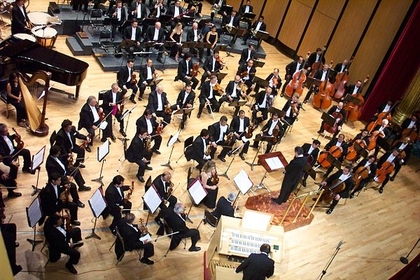Orchestra
Updated:
7 Sep 2020

Learn here
An orchestra is a large instrumental ensemble typical of classical music, which combines instruments from different families, including bowed string instruments such as the violin, viola, cello, and double bass, brass instruments such as the horn, trumpet, trombone and tuba, woodwinds such as the flute, oboe, clarinet and bassoon, and percussion instruments such as the timpani, bass drum, triangle, snare drum, cymbals, and mallet percussion instruments each grouped in sections. Other instruments such as the piano and celesta may sometimes appear in a fifth keyboard section or may stand alone, as may the concert harp and, for performances of some modern compositions, electronic instruments. A full-size Western orchestra may sometimes be called a ' or philharmonic orchestra (phil-, Greek for "loving" + "harmonic"). The actual number of musicians employed in a given performance may vary from seventy to over one hundred musicians, depending on the work being played and the size of the venue. A ' (sometimes concert orchestra'') is a smaller-sized ensemble of about fifty musicians or fewer. Orchestras that specialize in the Baroque music of, for example, Johann Sebastian Bach and George Frideric Handel, or Classical repertoire, such as that of Haydn and Mozart, tend to be smaller than orchestras performing a Romantic music repertoire, such as the symphonies of Johannes Brahms. The typical orchestra grew in size throughout the 18th and 19th centuries, reaching a peak with the large orchestras (of as many as 120 players) called for in the works of Richard Wagner, and later, Gustav Mahler. Orchestras are usually led by a conductor who directs the performance with movements of the hands and arms, often made easier for the musicians to see by use of a conductor's baton. The conductor unifies the orchestra, sets the tempo and shapes the sound of the ensemble. The conductor also prepares the orchestra by leading rehearsals before the public concert, in which the conductor provides instructions to the musicians on their interpretation of the music being performed. The leader of the first violin section, commonly called the concertmaster, also plays an important role in leading the musicians. In the Baroque music era (1600–1750), orchestras were often led by the concertmaster or by a chord-playing musician performing the basso continuo parts on a harpsichord or pipe organ, a tradition that some 20th-century and 21st-century early music ensembles continue. Orchestras play a wide range of repertoire, including symphonies, opera and ballet overtures, concertos for solo instruments, and as pit ensembles for operas, ballets, and some types of musical theatre (e.g., Gilbert and Sullivan operettas). Amateur orchestras include those made up of students from an elementary school or a high school, youth orchestras, and community orchestras; the latter two typically being made up of amateur musicians from a particular city or region. The term orchestra derives from the Greek ὀρχήστρα (orchestra), the name for the area in front of a stage in ancient Greek theatre reserved for the Greek chorus.